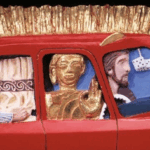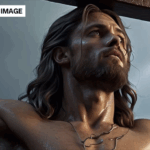This is an edited version of a sermon delivered at United Theological College on 24 April, 2019.
Take a breath, you can feel that post-Easter excitement. If you look at the lectionary readings for this week they are brimming with high-octane, beat pumping post-resurrection power. Christ has risen, he has risen indeed, and the risen Christ is the ascended Lord of Heaven and Earth who we await to judge the living and the dead and inaugurate the kingdom of peace and justice over all the earth. The energy is palpable, the joy is visceral, the good news is glorious. Yet buried in all the huzzahs is the not-to-be-overlooked detail in the Gospel of John that the risen Crist is the crucified Jesus. The One who has conquered death is the one whose body still bears the scars. The early Christians made a somewhat puzzling move as they began to develop their faith and witness around Jesus as Israel’s Messiah and the world’s Lord, they continued to talk about the crucifixion. We risk moving too easily past this shocking move. They had the resurrection, they had post-Easter experiences of Jesus, present in their midst, why did the crucifixion take such a central position?
And central it became – the disciples would preach the resurrection but the resurrection only comes through the crucifixion, it can never be unshackled. The ascended Lord is the crucified Messiah; the risen Christ bears the scars. We cannot help but be excited post-Easter (and we should be excited, Christ is risen he is risen indeed, God has vindicated the life and ministry of Jesus Christ and in so doing conquered Sin and Death and shown the way to abundant life) – but we cannot forget that the resurrection and the life comes through the suffering and humiliation of Jesus who stood in solidarity with all who suffer, all who are degraded and dehumanised by the violence of our worldly systems, all who suffer the desolation and dereliction of feeling abandoned by God, all those vulnerable and victimised by those they thought were friends. And because we cannot forget that Jesus is with those huddled masses living lives of quiet desperation, we cannot forget them. In our excitement for the glorious victory of the resurrection we must not establish a movement at the expense of those crucified today. As the resurrected body is not true resurrected body without the scars, so the church is not the body of Christ without those crucified by the world and its ways today.
There have been too many times the church has sought to cover its wounds with the might and glory of the world. Too often we have been tempted to disconnect Jesus from the cross and envision an unblemished Christ (victorious upon the clouds) overwhelming all that see, so that they have no choice but to wail. Yet there is no disconnecting Jesus from the cross and its horrors. When Jesus appears to the disciples he says peace be with you three times – after the first he gestures to his visible wounds, after the second he breathes out the Spirit and entrusts to the disciples a ministry of forgiveness – sending them out into what will prove to be an unforgiving world; full of its own crosses and crucibles. With the third ‘peace be with you’ he returns to the wounds inviting the one who doubted to touch. This is the peace of Jesus, this is the peace of the Spirit, this is the peace of the church – not of gunboats but of wounds, not of obliteration but of forgiveness, not of bravado but of invitation. There is no break, the same wounded, resurrected Christ, is the ascended and acknowledged ruler of the kings of earth. The Jesus we will see on the clouds is the pierced one and all will recognise that they are one in the same.
One of the few patterns of animal behaviour to reach near ubiquitous knowledge is the nature of buffalo herds. Buffalo herds, so it is passed to us, travel at the pace of the slowest, oldest, weakest buffalos so that when the herd is under attack, the young, strong, and healthy can easily speed up and escape, those who cannot keep the pace are left behind to – putting it euphemistically – contribute one last time to the circle of life. Had the church isolated the resurrection of Christ and apocalyptic visions of the second coming from the grim reality of the shock, humiliation, and scars of the crucifixion, it would have easily found itself a church of buffalo. After all, without the cross where the scandal, where the folly, where the stumbling block? How easily would an unblemished victorious faith fit with the ideologies and political visions of the world – and history has shown this has been a temptation – but how hollow that news would be to those who knew the herd moved with them only while it was convenient.
The church however, which saw no way to the resurrection save through the cross, which confessed it had touched the wounds on Christ’s resurrected body, which proclaimed that the ascended Lord would be recognisable to those who pierced him, that church moves at the pace of its ‘slowest’ members because that is the pace of our Messiah, our Lord. The locus of our hope and salvation is a body of One who died in humiliation and dereliction – in solidarity with all who suffer such descents into hell – and though that One was raised and vindicated by the God of life and love, the body bore the scars, like Israel struck on the hip, the resurrected body of Jesus the Christ walks with a limp. And if we speed up too fast, if are too tempted by the glory and the victory, if we are too committed to an unblemished appearance we leave him, and all those vulnerable, to the lions.
And while this is a warning, it is also the good news. It is good news to those who society has no problem leaving behind if things get too difficult, or too inconvenient, or too expensive. When I read the story of Thomas and the wounded Christ, I cannot do so without the work of Nancy Eiesland crashing into my office. Professor Eiesland wrote out of her experience of lifelong disability and, in her seminal work The Disabled God, she reminds the church that in this scene with the disciples, the resurrected Christ makes good on the promise of the Incarnation that the fullness of human life and contingency would be incorporated into the life of God. “In presenting his impaired hands and feet to his startled friends, the resurrected Christ is revealed as the disabled God. Jesus, the resurrected Savior, calls for his frightened companions to recognize in the marks of impairment their own connection with God, their own salvation. In doing so, this disabled God is also the revealer of a new humanity.” The impaired body of the resurrected Christ shows that the bodies of those with disabilities “participate in the imago Dei, not in spite of… impairments and contingencies, but through them.”
This is part of the radical good news of the Easter message – this is part of the thrilling, adrenalin pumping post-Easter readings – this is part of the church. The resurrection comes through the crucifixion, the resurrected Christ bears the scars, no one is left behind, no one is steamrolled as we labor unto glory. The church is the body of Christ when it refuses to hide the scars, when it finds its identity through collaboration with those crucified people today – those whose life and value is radically transfigured by the Incarnational proclamation – those whose treatment by the church is synonymous with the treatment of Christ. Just because we now have, in Christ, victory over Sin and Death, we are not now in a position to discard the crucified Jesus, or any he stands in solidarity with, wounds and all. And to those who may have been, or are presently, feeling the abandonment of a church that couldn’t adjust practice or proclamation to keep in step with you, do not grieve – it is the church who has moved on without Christ. Jesus – the Incarnate One, the Resurrection and the Life – is walking at whatever pace you go, because, as the one who bears the wounds of the world and its humiliating violence, that is as fast as he will ever go.
And for those of us who need the reminder to slow the pace, to walk against the world’s efficiency, we give thanks that we have embodied practices such as the Eucharist, signifying the solidarity and reconciliation of the cross and resurrection. The Eucharist, to close with Eiesland, is where we find:
“God among humankind, the temporary able-bodied with people with disabilities, as we ourselves with our own bodies. In the Eucharist, we encounter the disabled God, who displayed the signs of disability, not as a demonstration of failure and defect, but in affirmation of connection and strength. In this resurrected Christ, the nonconventional body is recognised as sacrament. Christ’s solidarity with the more than 600 million people with disabilities worldwide is revealed in the Eucharist.”
Christ has risen, he has risen indeed.
Liam Miller is the Northern Hub Mission Resource Worker for the Sydney Central Coast Presbytery and a ministry candidate.












